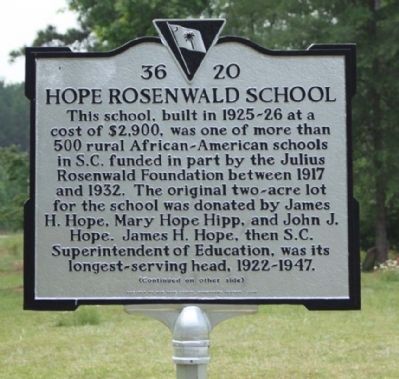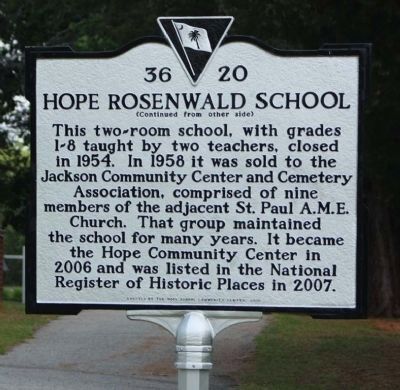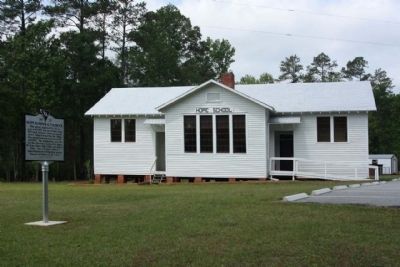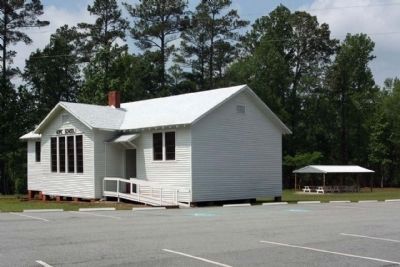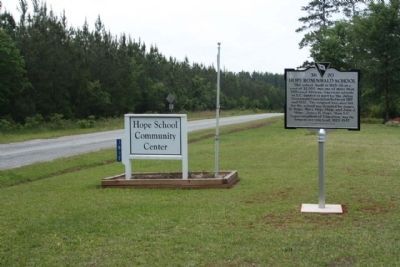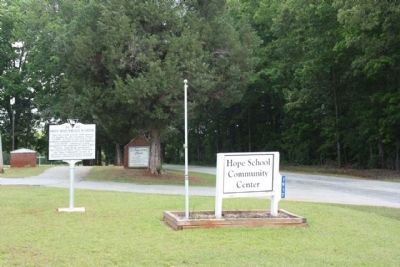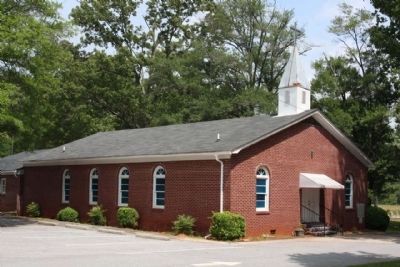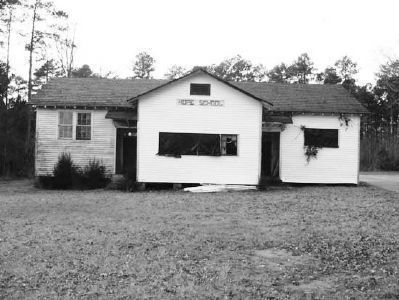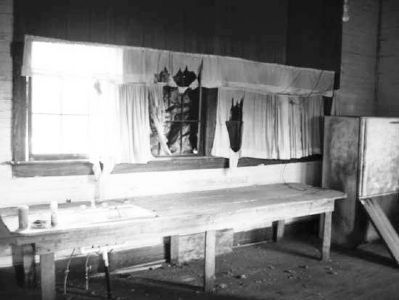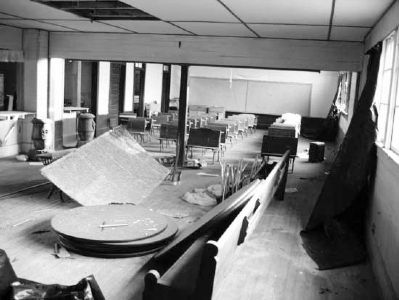Pomaria in Newberry County, South Carolina — The American South (South Atlantic)
Hope Rosenwald School
This school, built in 1925-26 at a cost of $2,900, was one of more than 500 rural African-American schools in S.C. funded in part by the Julius Rosenwald Foundation between 1917 and 1932. The original two-acre lot for the school was donated by James H. Hope, Mary Hope Hipp, and John J. Hope. James H. Hope, then S.C. Superintendent of Education, was its longest-serving head, 1922-1947.
This two-room school, with grades 1-8 taught by two teachers, closed in 1954. In 1958 it was sold to the Jackson Community Center and Cemetery Association, comprised of nine members of the adjacant St. Paul A.M.E. Church. That group maintained the school for many years. It became the Hope Community Center in 2006 and was listed in the National Register of Historic Places in 2007.
Erected 2010 by The Hope School Community Center. (Marker Number 36-20.)
Topics and series. This historical marker is listed in these topic lists: African Americans • Education. In addition, it is included in the African Methodist Episcopal (AME) Church, and the Rosenwald Schools series lists. A significant historical year for this entry is 1917.
Location. 34° 16.203′ N, 81° 21.869′ W. Marker is in Pomaria, South Carolina, in Newberry County. Marker is on Hope Station Road near Peak Road (South Carolina Highway 36-33), on the right when traveling south. Touch for map. Marker is at or near this postal address: 1917 Hope Station Road, Pomaria SC 29126, United States of America. Touch for directions.
Other nearby markers. At least 8 other markers are within 6 miles of this marker, measured as the crow flies. St. John's Church (approx. 1.3 miles away); Pomaria (approx. 2.9 miles away); Peak (approx. 3.1 miles away); Folk-Holloway House (approx. 3.2 miles away); Nuclear Power (approx. 3½ miles away); Lutheran Theological Southern Seminary (approx. 3½ miles away); Bethlehem Lutheran Church (approx. 4 miles away); Rev. Joachim Bulow. (approx. 5½ miles away). Touch for a list and map of all markers in Pomaria.
Regarding Hope Rosenwald School. The Hope Rosenwald School is significant for its role in African-American education and social history in South Carolina between 1925 and 1954, and as a property that embodies the distinctive features of a significant architectural type and method of schoolhouse construction popular throughout the southern United States in the early twentieth century. Like other Rosenwald schools, the Hope Rosenwald School can trace its origins to the contentious debate over the education of southern African-Americans in the late nineteenth and early twentieth centuries. While the end of the American Civil War had brought about state-initiated funding and operation of some local schools for black children in the South, the policies emphasizing racial segregation during the Jim Crow era left southern blacks with few opportunities for a truly complete primary education and even fewer secondary school options. Among those who sought a method for insuring that black educational opportunities in the South might be improved was Julius Rosenwald, CEO of Sears & Roebuck and a trustee of the Tuskegee Normal and Industrial Institute. At the request of Booker T. Washington, Rosenwald began a school building fund to benefit southern African-Americans, especially those in rural regions, and from 1917 to 1932, Rosenwald’s program led to the construction of more than 5300 public schools, teachers’ homes, and instructional shops in fifteen southern states, nearly 500 of which were located in South Carolina. Listed in the National Register October 3, 2007. (South Carolina Department of Archives and History)
Additional commentary.
1. National Register of Historic Places:
Hope Rosenwald School (added 2007 - - #07001045)
Also known as Jackson Community Center
♦ Historic Significance:Event,Architecture/Engineering
♦ Architect, builder, or engineer: Dresslar, Fletcher B., Smith, Samuel L.
♦ Architectural Style: Colonial Revival
♦ Area of Significance: Education, Architecture
♦ Period of Significance: 1950-1974, 1925-1949
♦ Owner: Private
♦ Historic Function: Education
♦ Historic Sub-function: School
♦ Current Function: Education, Work In Progress
♦ Current Sub-function: School
— Submitted May 3, 2011, by Mike Stroud of Bluffton, South Carolina.
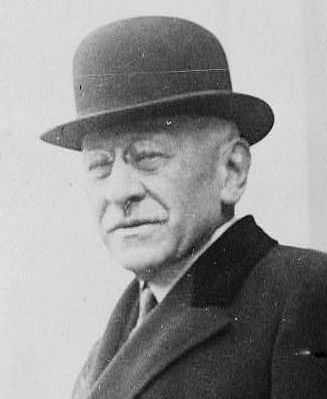
from the United States Library of Congress, circa 1929
11. Julius Rosenwald
Over the course of his life, Rosenwald and his fund donated over 70 million dollars to public schools, colleges and universities, museums, Jewish charities and black institutions. The rural school building program was one of the largest programs administered by the Rosenwald Fund. It contributed more than four million dollars in matching funds to the
construction of more than 5,000 schools, shops, and teachers' homes in the South. These schools became informally known as "Rosenwald Schools."
Credits. This page was last revised on January 18, 2024. It was originally submitted on May 3, 2011, by Mike Stroud of Bluffton, South Carolina. This page has been viewed 990 times since then and 53 times this year. Photos: 1, 2, 3, 4, 5, 6, 7, 8, 9, 10. submitted on May 3, 2011, by Mike Stroud of Bluffton, South Carolina. 11. submitted on May 5, 2011, by Mike Stroud of Bluffton, South Carolina.
